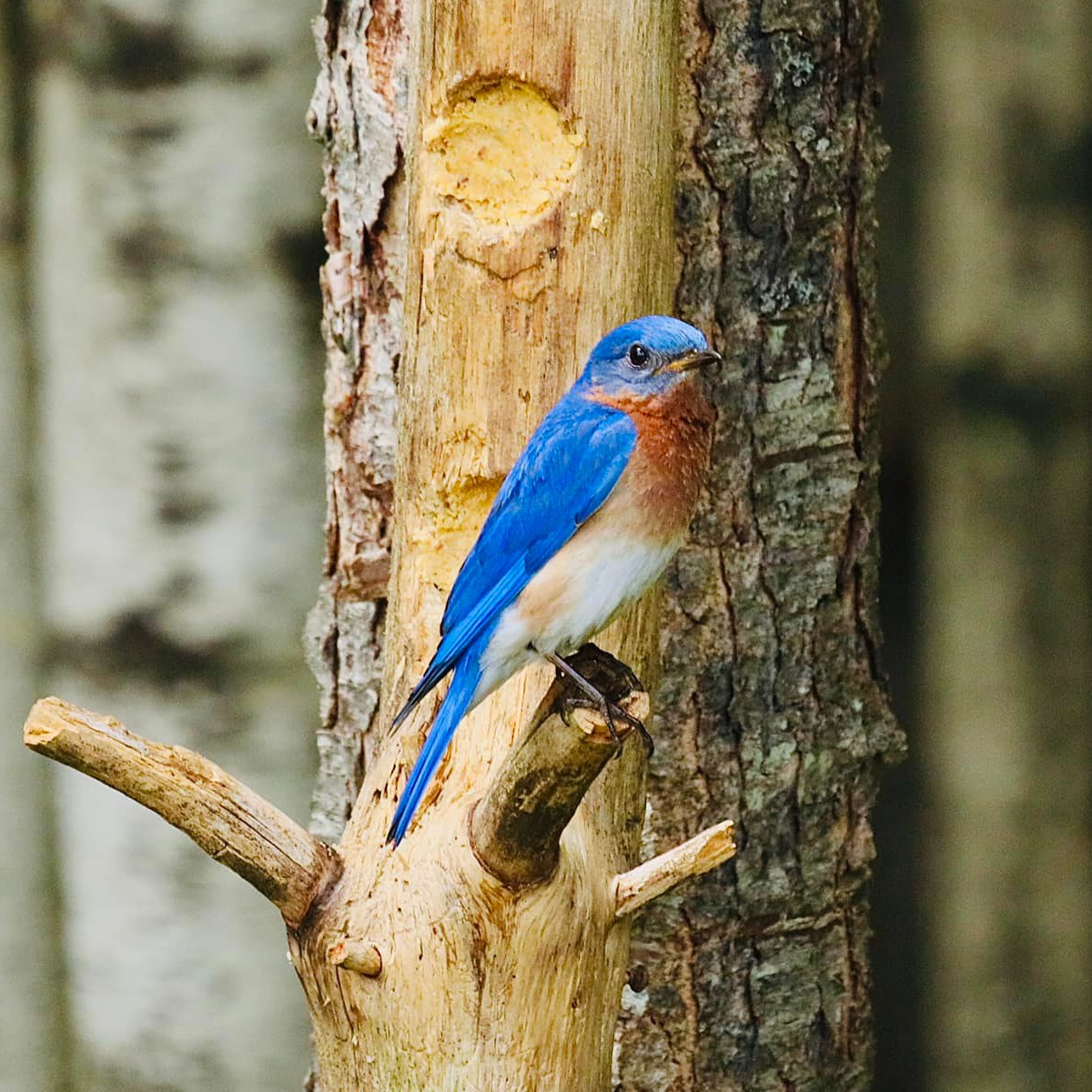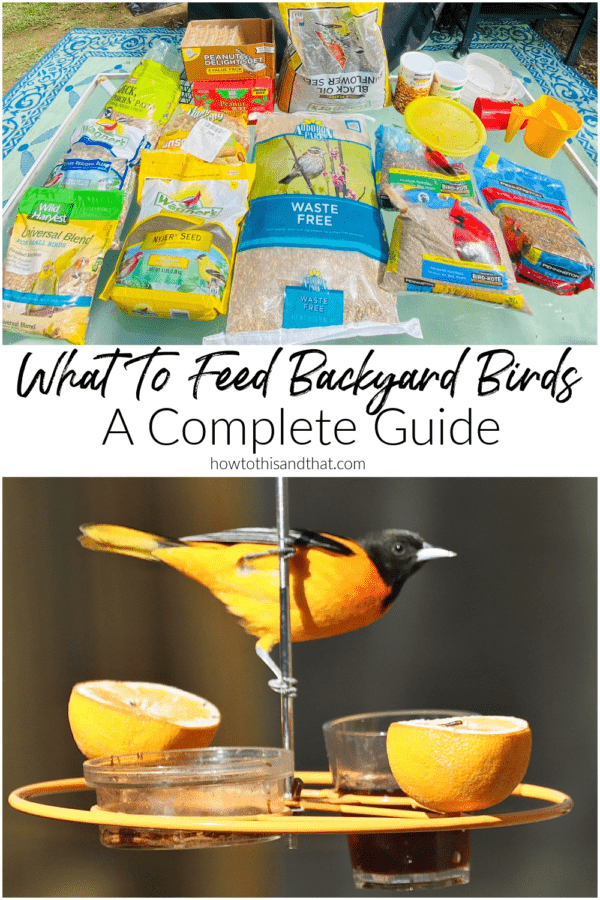
Feeding backyard birds can be a fun and rewarding hobby, but it's important to know what to feed them in order to ensure their health and well-being. If you have been looking for a complete guide on how to feed backyard birds, check out this post then get yourself a new feeder, like maybe a window bird feeder and enjoy.
Backyard birds can be so much fun, but if you want to help feed them and provide for them, it is important to know the best things to feed them and it is very important to know what you shouldn’t be feeding them. The goal of feeding wild animals is to help them, not impact their health and wellness.
A Complete Guide on What to Feed Backyard Birds
Below is a complete guide on what to feed backyard birds, but before we get into this, let’s first talk about the benefits of backyard birds and why we want to attract them.
Benefits of Attracting Birds to Your Backyard
Attracting birds to your backyard can have lots of benefits! Read on:
They Help Pollination
If you love attracting hummingbirds into your yard, you are helping pollination! If you have flowers planted in your yard, hummingbirds will help to pollinate said flowers. You can’t go wrong there!
They Help You Create an Entire Ecosystem in Your Yard
Attracting backyard birds often means planting flowers and native plants in your yard. Planting a variety of native plants and flowers attracts more than just birds. These plants will attract bees, butterflies, moths, and more to your backyard which enhances the entire ecosystem.
They Provide Fun and Interesting Learning Opportunities
Not only are backyard birds great for introducing yourself and your family/children to the outdoor world, but they also provide great opportunities for learning. When a bird makes an appearance in your backyard, you can look up information based on its colors and appearance in order to learn all about them. A Window Bird feeder makes a great way to see them close up.
You can download a birdwatching app or get a guidebook on how to identify birds to help you learn all about it. An app or a guide will help you to learn about the favorite foods of each particular species, whether they prefer to eat from platform feeders, tube feeders, or whether they are ground-feeding birds.
They are Pretty and Fun to Watch
If you don’t want an educational lesson, you don’t have to have one. A real bird lover will know how great it can be to simply sit back and enjoy watching the different birds in your yard is fun! They are so beautiful and graceful, I could watch them all day.
Be sure to have some binoculars on hand to help you get the best views of them. Or, get a window bird feeder. I am sorry, I did I mention that my favorite feeder sits in our window?
They Help Get Rid of all of those Unwanted Bugs
Birds are great bug eaters! Chickadees, for example, are insect-eating birds and one single nest of baby chickadees can consume upwards of 9,000 caterpillars in just one season! Isn’t that amazing?! So if you are looking for ways to keep the bugs down around your garden this year, look for ways to attract those birds! Here is a short list of other bugs that are often eaten by backyard birds:
- Grasshoppers
- Termites
- Grubs
- Aphids
- Spiders
- Weevils
- Crickets
- Beetles
- Centipedes
- Ants
Do you find yourself dealing with any of these pests? Birds might just be the best way to get them out of your yard and garden! I definitely prefer birds over poison.
What to Feed Backyard Birds
Now that we know some of the benefits of attracting birds into our yards, let’s talk about what to feed backyard birds:
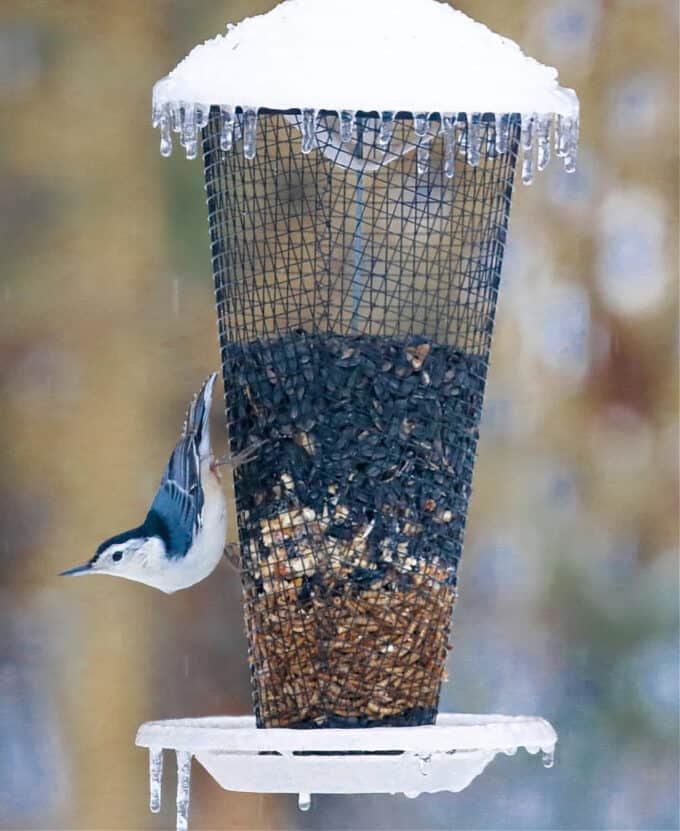
Seeds
Seeds are a staple food for many backyard birds. Many different types of seeds will keep the birds in your yard quite happy. You can offer a variety of seeds such as black oil sunflower seeds, millet, safflower seeds, and nyjer thistle seeds. Black-oil sunflower seeds are especially popular among many species of birds, as they are high in fat and protein.
Window Bird Feeder
A window bird feeder is an amazing , inexpensive way to feed the birds up close, especially during the winter. For about $25 you can hang it in any window and add seed easily.
To use your window bird feeder, you simply put the window down, fill the seed and call it good. Birds of all kinds will fly in and out causing enjoyment and entertainment for you and doing what they need to do... eat and store.
You can purchase many types of seed mixes at farm supply stores. You will also find a wide variety of feeders at these stores as well.
Pictured here is a few of the types we buy & a quick basic list of who eats what.
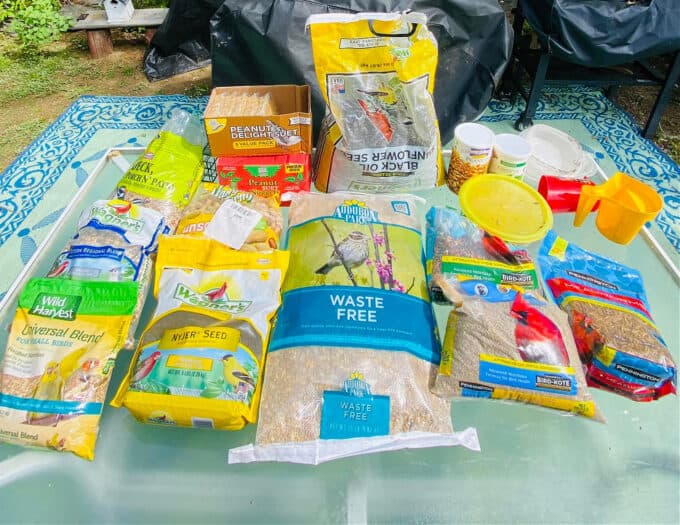
- Black Oil Sunflower Seed- Cardinals, Chickadees, Titmouse, Nuthatches & many others
- Millet- Finches love it (goldfinch, purple, house)
- Peanuts- Nuthatches, Woodpeckers, Blue Jays
- Milo and Cracked Corn- most ground feeding birds like Towhees, Doves, Pigeons, Grackles, Blackbirds and Cowbirds.
Of course there are many more bird species and many other types of feed, this is just the basic.
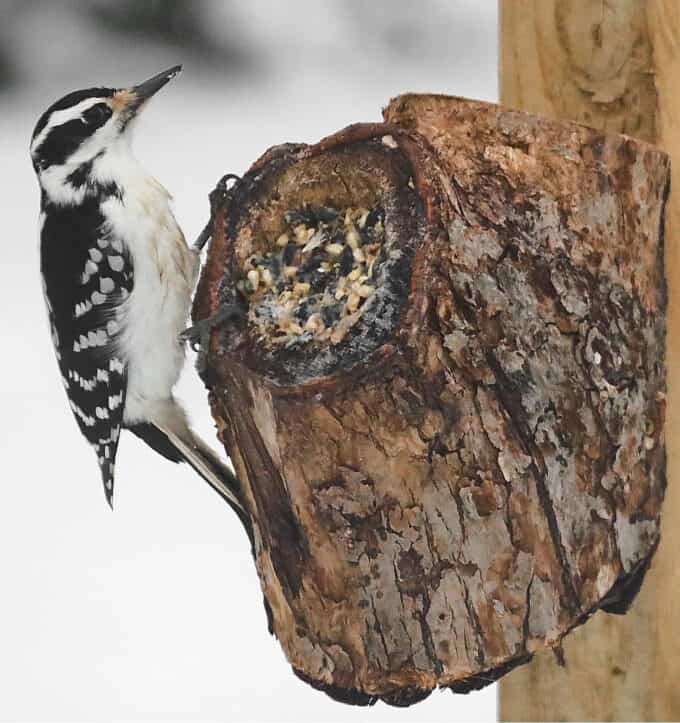
Suet
Suet is a high-energy food that can be fed to birds all year round but is especially beneficial during the winter months when birds need extra energy to stay warm. This food is often served to birds in the form of suet cakes. If you don't know what suet is, it is made from rendered beef or pork fat and can be mixed with other ingredients such as seeds, nuts, and dried fruit.
Suet cages (wire cage that holds the suet) are a great way to feed this to birds, and they are relatively inexpensive to purchase at Amazon or at farm supply stores such as Tractor Supply.
Stay tuned for my homemade suet recipe.
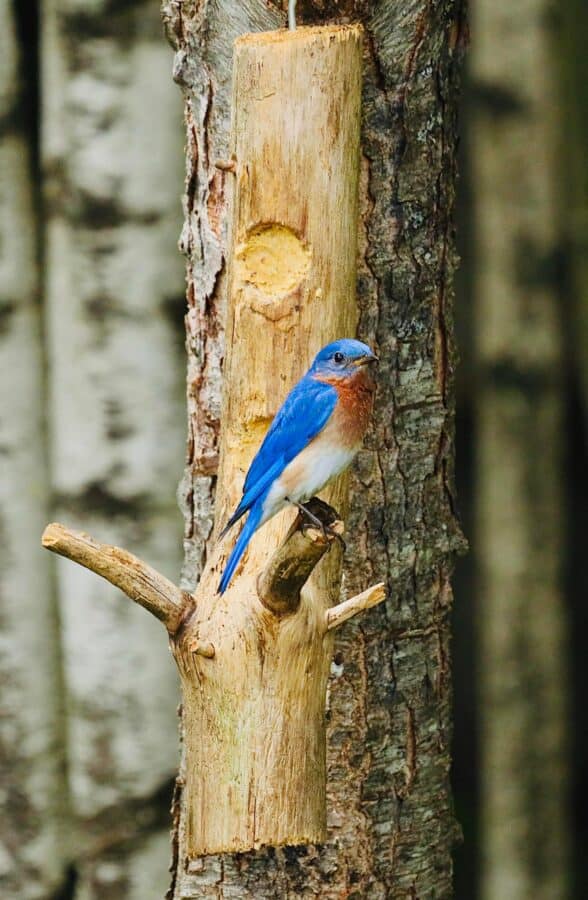
Nuts
Nuts are a great source of protein and healthy fats for birds. Peanuts, almonds, and walnuts are all good choices, but make sure to offer them in a feeder that is designed for nuts so that the birds can easily access them.
Fruits and Berries, Even Jelly
Many birds enjoy eating fruits and berries, especially in the summertime when they are plentiful. You can offer fresh or dried fruits such as apples, oranges, cranberries, and raisins.
Some birds like Orioles and Catbirds love grape jelly. You can easily attract these beauties to your yard by hanging an Easy Homemade DIY FEEDER like ours OR purchasing one specifically for them, like pictured below.
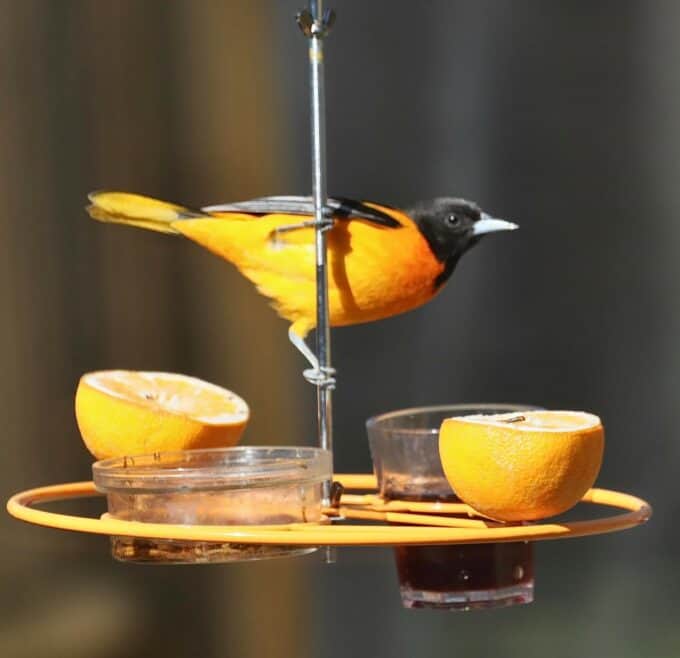
Mealworms
Mealworms are a great source of protein for birds, especially during the nesting season when they need extra nutrition. You can buy live or dried mealworms and offer them in a feeder or on a platform.
There is nothing quite like feeding mealworms to birds. They can’t really hide their excitement over this yummy treat! Often times, they will become so eager to gobble the mealworms, that they will eat them right from your hand.
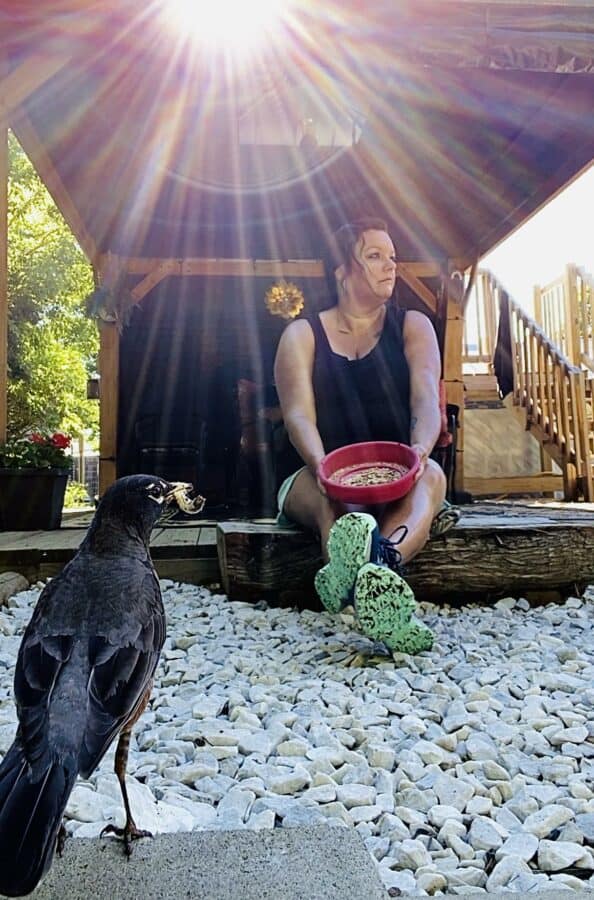
Safflower Seed
If you are looking to discourage squirrels and other small animals from eating the bird food that you have set out for them, you might consider feeding safflower seeds. These are a good option as birds are typically the only critters like that safflower. Many birds enjoy safflower seeds, including cardinals, chickadees, and finches. However, the squirrels and some other bird "pests" think they taste bitter. Therefore, they stay away.
I will note here though that I have never really had luck with safflower. My birds don't seem to care for them. So, if I buy a mix and they are in it, fine if not, I don't purchase them separately.
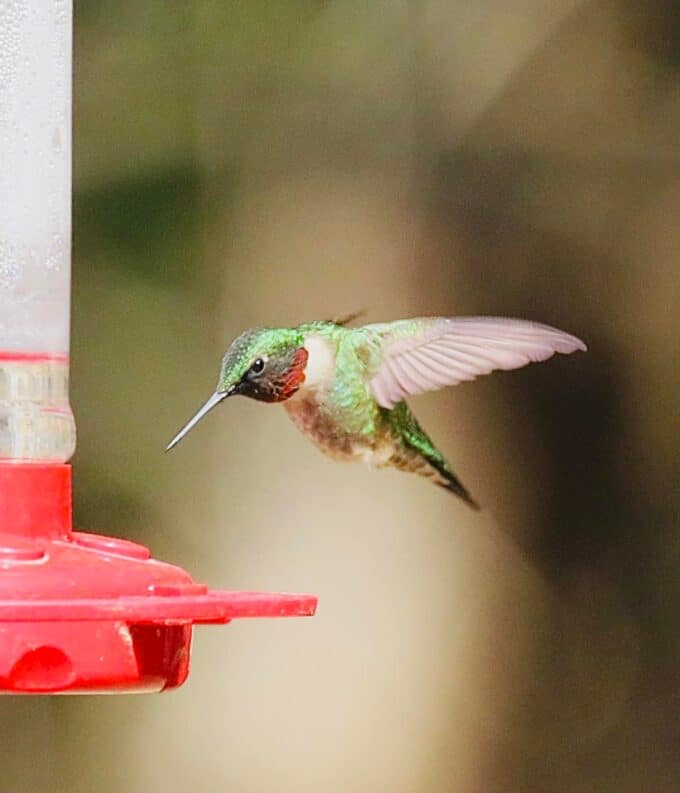
Sugar Water
Some birds, such as hummingbirds, thrive when given sugar water. Combine 4 parts water (hot) with one part sugar and put it into a special feeder like a hummingbird feeder.
Also worth noting is that while you may often see hummingbird feeders with red sugar water, please don't add food coloring as it is not from natural food sources and not a part of a hummingbird's natural diet. Try to avoid the store bought colored nectar at all costs. It is actually less expensive to mix your own as above.
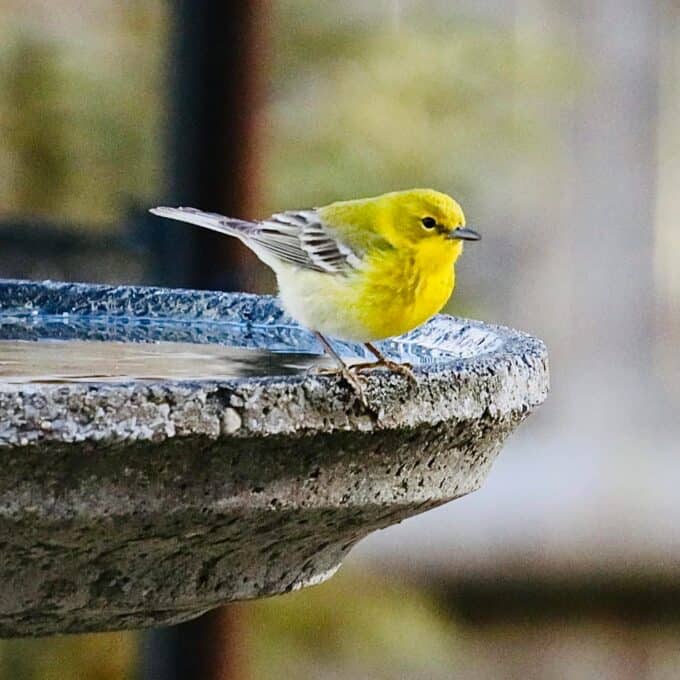
Water
In addition to food, it's important to provide fresh water for backyard birds, separate from their food dish. You can offer water in a bird bath or in a shallow dish. Make sure to change the water regularly to prevent the growth of bacteria and other harmful microorganisms. Your feathered friends will thank you!
A great place to find birdbaths is on Amazon, I am not an affiliate so you won't find me pushing certain ones for sales. I recommend what we use and love, that is it. We have a cement birdbath and a resin one. To be honest, I prefer the resin. It is easier to clean, easier to move withstands weather and is very inexpensive coming in arouns $30-40.
Foods to Avoid Giving to Backyard Birds
It's important to note that not all foods are suitable for backyard bird feeding. I know you want to feed birds to keep them happy and full, but you really do have to be careful. Not all foods are good for birds. As a matter of fact, some foods could be harmful to their health. Here are some foods to avoid feeding to backyard birds:
- Bread
- Crackers
- Salted Nuts or Dry Roasted Nuts, although unsalted peanuts are fine
- Anything Salty
- Cooking oils or grease from meat (this can cause damage to the waterproofing properties of the bird’s feathers)
- Dairy Products
- Onions
- Garlic
- Cooked Oats (raw oats in suet mixes are fine)
- Chocolate and Candy
- Any processed foods
This what not-to-feed list is generally acceptable for all different types of birds, but if you have a specific bird species in your yard that you are feeding often, it is always a good idea to do some research to make sure that you aren't feeding it the wrong things. It's always best to stick with natural foods that won't upset the birds' health or dietary system.
Also worth noting- It is important to make sure to clean feeders and bird baths regularly to prevent the spread of disease. For example- conjunctivitis is VERY common in finch breeds and can spread like wildfire. Other birds will often avoid feeders where an infected finch has been. So if you suddenly notice a feeder is not being used, this could be why.
Feeding birds through winter
A common mistake people make is assuming the birds either all migrate or hibernate for the winter and do not need food. Some simply don't want the hassle of getting out in the cold to continue feeding. However, if you can manage it is a great idea to at least keep one good metal feeder going for the winter. The birds will go where the food is, so if necessary, bring it closer to your house, porch or deck.
Another fantastic option for winter feeder is this inexpensive set up- the hanging cedar platform was $10 from Walmart. The hanging cover was $12 from Tractor Supply. It helps keep the snow out and protects the birds. As you can see, some snow gets in if it has been a crazy storm. I simply empty the feeder, bang out out and refill. Let's not also forget the famous (my favorite) window bird feeder, it is perfect for winter.
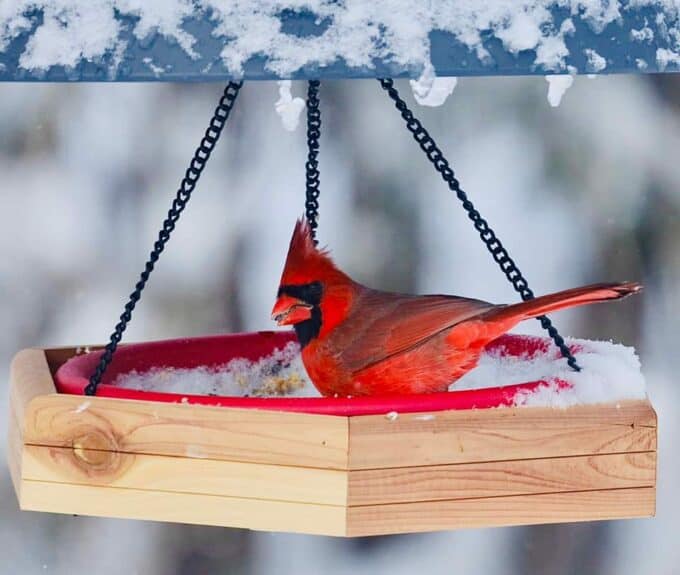
By offering a variety of foods and providing fresh water, you can attract a wide variety of birds to your backyard and provide them with the nutrition they need to stay healthy and happy. Giving you both so much joy and fun to come.
Please feel free to ask ANY questions in the comments. We are very bird educated and love to help. It is a huge passion and hobby of ours. Enjoy!

Owner & Lead Recipe Developer for It's Simple! since 2015, where you will find our best Family Favorites & Keto Low Carb Dishes with Helpful Cooking Tips & Hints in each post. Many Thanks for Stopping By, Enjoy!


